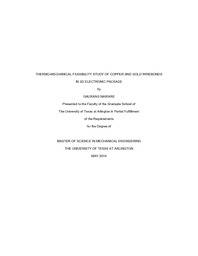
ATTENTION: The works hosted here are being migrated to a new repository that will consolidate resources, improve discoverability, and better show UTA's research impact on the global community. We will update authors as the migration progresses. Please see MavMatrix for more information.
Show simple item record
| dc.contributor.author | Naware, Gaurang | |
| dc.date.accessioned | 2017-05-31T19:24:06Z | |
| dc.date.available | 2017-05-31T19:24:06Z | |
| dc.date.submitted | January 2014 | |
| dc.identifier.other | DISS-12655 | |
| dc.identifier.uri | http://hdl.handle.net/10106/26681 | |
| dc.description.abstract | 3 Dimensional (3D) Electronics Packaging has emerged as a revolutionary trend in the micro-electronics industry. It has made possible cost-effective system integration and size scaling while reducing the interconnect delay. The ever increasing demand for better mechanical, thermal, electrical performance, improved reliability and cost effective semiconductor manufacturing technology has encouraged the engineers to replace Gold (Au) by Copper (Cu). In a survey conducted by Semiconductor Equipment and Materials International, to study the industry mood related to wirebond technology, it was observed that 72% of the leading semiconductor companies are considering switching to Cu [1]. The only major concern regarding the use of Cu as an interconnect material is the in-service product reliability and unproven historical record. To facilitate a smooth transition from Au to Cu there is a need to carryout in depth research and analysis since material changes require requalification. Since there is a dearth of study on the reliability of Cu wirebond packages there is an urgent call for research to address the needs of ever growing semiconductor industry. Thermo-Mechanical stresses are introduced in a package during fabrication processes or field use due to constant rise and fall in temperature. The mismatch in the Coefficient of Thermal Expansion (CTE) between various components results in significant mechanical stresses in the package. The overmold and wirebond have a considerable difference in there CTE's. Finite Element model was developed to simulate reliability tests for 3D wirebond package. Reliability test, Accelerated Thermal Cycling (ATC) or Thermal shock test was simulated on a 3D wire bonded package. The thermo-mechanical response of package during Accelerated Thermal Cycling test was studied. Comparative analysis of thermo-mechanical response of the packages was carried out for different overmold compounds. Creep behavior of materials is used to capture their response during various temperatures and with time. Bilinear hardening curve is used to capture plastic deformation. Further the mechanical response of gold wirebond package is compared with that of copper wirebond package. The results were further utilized to carry out a parametric analysis to study the effect of wirebond diameter and number of wirebond on mechanical behavior the package. | |
| dc.description.sponsorship | Agonafer, Dereje | |
| dc.language.iso | en | |
| dc.publisher | Mechanical Engineering | |
| dc.title | Thermo-mechanical Feasibility Study Of Copper And Gold Wirebonds In 3D Electronic Package | |
| dc.type | M.S. | |
| dc.contributor.committeeChair | Agonafer, Dereje | |
| dc.degree.department | Mechanical Engineering | |
| dc.degree.discipline | Mechanical Engineering | |
| dc.degree.grantor | University of Texas at Arlington | |
| dc.degree.level | masters | |
| dc.degree.name | M.S. | |
Files in this item
- Name:
- Naware_uta_2502M_12655.pdf
- Size:
- 1.391Mb
- Format:
- PDF
This item appears in the following Collection(s)
Show simple item record


